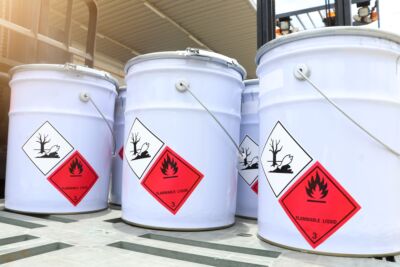 Pipe identification tags and valve tags are easily overlooked but essential to maintaining a safe work environment. They’re often used to identify piping systems that transport materials such as fuel, oils, water supplies and other fluids from one location to another. OSHA and other regulatory entities maintain strict guidelines for pipe marking. For example, markings must be easily legible with bold black text or white text against a color-coded background.
Pipe identification tags and valve tags are easily overlooked but essential to maintaining a safe work environment. They’re often used to identify piping systems that transport materials such as fuel, oils, water supplies and other fluids from one location to another. OSHA and other regulatory entities maintain strict guidelines for pipe marking. For example, markings must be easily legible with bold black text or white text against a color-coded background.
When it comes to pipe identification tags, durability, strength and visibility are essential. They must be durable enough to withstand heat, chemicals, weather and other factors that can destroy them. They should be clearly visible in case of an emergency and communicate important information such as internal pressure, temperature and if the pipe contents include hazardous substances. For these reasons, pipe marking is a crucial part of workplace safety and essential for all facilities that contain piping systems.
Ensure Safety When Transporting Hazardous Materials
 Safety is always paramount when it comes to transporting hazardous materials or products, so it’s important for employees to have a way to identify what material is being transported through your piping system at all times. Pipe labels make it easy to see exactly what a pipe contains and how it’s being used throughout a facility. Clear and visible pipe labeling reduces the chances of dangerous workplace accidents to help keep employees safe. And, if an emergency such as a burst or broken pipe occurs, pipe custom labeling makes it easier for emergency responders to identify exactly what material has spilled.
Safety is always paramount when it comes to transporting hazardous materials or products, so it’s important for employees to have a way to identify what material is being transported through your piping system at all times. Pipe labels make it easy to see exactly what a pipe contains and how it’s being used throughout a facility. Clear and visible pipe labeling reduces the chances of dangerous workplace accidents to help keep employees safe. And, if an emergency such as a burst or broken pipe occurs, pipe custom labeling makes it easier for emergency responders to identify exactly what material has spilled.
Follow OSHA Compliance and Industry Labeling Standards
While OSHA did not create its own standards for pipe marking, it references standards from ANSI/ASME A13.1, the most widely recognized pipe identification standard in the U.S. The ANSI/ASME A13.1 standard uses six predefined colors and four user-defined colors to identify pipe contents and flow direction. It also identifies hazards that could risk health and safety. A clear and comprehensive color code helps make a complex system of pipe markings easier to understand. This color coding also ensures that, in case of an emergency, emergency responders can easily identify the exact contents of a pipe and the specific hazards they’re facing.
- Red (white text) = Fire-quenching substances
- Orange (black text) = Toxic and/or corrosive materials
- Yellow (black text) = Flammable/oxidizing fluids & gasses
- Brown (white text) = Combustible fluids & gasses
- Green (white text) = Water
- Blue (white text) = Compressed air
- Purple (white text) = user-defined
- White (black text) = user-defined
- Gray (white text) = user-defined
- Black (white text) = user-defined
 In order to keep your facility compliant with regulatory standards, all piping systems should be clearly labeled in accordance with color scheme standards set forth by ANSI/ASME A13.1. Additional regulations can apply depending on what kind of piping system your facility utilizes. For example, IIAR Bulletin 114 standardizes identification for ammonia refrigeration piping systems, and ISO 14726 governs how labels should be applied to onshore and offshore marine pipes.
In order to keep your facility compliant with regulatory standards, all piping systems should be clearly labeled in accordance with color scheme standards set forth by ANSI/ASME A13.1. Additional regulations can apply depending on what kind of piping system your facility utilizes. For example, IIAR Bulletin 114 standardizes identification for ammonia refrigeration piping systems, and ISO 14726 governs how labels should be applied to onshore and offshore marine pipes.
If your facility is located outside the United States, you may need to adhere to different pipe labeling standards. The British Standard (BS) 1710 specifies how pipe markers should be designed and placed in the United Kingdom, and the Indian Standard (IS) 2379 does the same for facilities in India. Our team can help you navigate which standards your facility needs to follow when it comes to pipe labeling.
Make Maintenance Easier
Clearly readable pipe marking makes it easy for employees to quickly distinguish pipes and valves during the maintenance process. It also makes it easier to trace repairs and keep track of which pipes have been serviced and which still need attention. Pipe marking can help save valuable time (and money) while making your facility more efficient without sacrificing safety. It also makes it easier to keep a regular maintenance schedule and prevents pipes from potentially being left unserviced for long periods of time.
Important Factors to Consider for Pipe Identification Tags
In pipe labeling, there are specific guidelines for placement to meet ANSI/ASME A13.1 standards. Pipe labels must clearly show any combination of full name, abbreviation or chemical symbol to identify the pipe contents, in addition to the proper color code. A few important factors to consider for pipe marking projects include:
- Pipe markings should be placed adjacent to all valves, flanges and changes in direction.
- Pipe markings should communicate changes in direction of flow.
- Pipe markings should be placed in intervals of 25 to 50 feet on straight runs.
- Pipes must be marked on both sides of floor or wall penetrations.
- Pipe marking standards indicate that pipe markings should be easily visible to employees from any point of normal approach.
You should also make sure pipe markers are tested in a variety of conditions before installing them in your facility. They should be able to stand up to UV damage, extreme temperatures, high humidity and other conditions. Pipe markers should also be resistant to solvents that can fade labels and render them illegible, such as salt and acids.
The Metal Marker Advantage
Since pipe marking plays a crucial role in the safety of your facility, you should only work with the best in the industry. Metal Marker Manufacturing brings valuable knowledge and experience to pipe identification products. With nearly a century in the business, we understand the ins and outs better than anyone. Our high-quality metal tags and metal labels are recognized industry-wide thanks to our commitment to fast turnarounds and competitive prices. We’ll help you label your pipes according to the marking standards of your industry at an unbeatable and economical price point.
Get Started With Pipe Markers and Ensure a Safe Workplace
Pipe markers communicate essential information and help keep facilities of all sizes safe for employees and emergency responders by clearly labeling pipe contents, flow direction and more. We can help you keep your facility safe and compliant with industry standards with durable and visible pipe labels. Call 1-800-428-0095 or contact us online to get started.